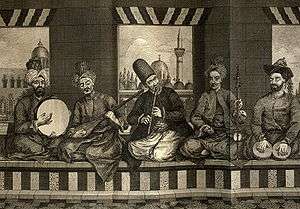Alwan al Showaya
| Alwan al Showaya | |
|---|---|
 | |
| Background information | |
| Birth name | Alwan al Ahowaya Abu Ahahla |
| Origin | Iran |
| Died | August 18, 1980 |
| Genres | Classic folk |
| Occupation(s) | Singer, songwriter, composer, instrumentalist |
Alwan al Showaya (Arabic: علوان الشویع) was a singer from al-Ahwaz, Iran. He was the inventor of the Arabic singing style “ʿAlwānī”, a term derived from his name. Alwan's music used the rabab, a traditional instrument of Khuzestan.
Personal life
| Part of a series on |
| Arab culture |
|---|
Alwan was born in an Arabian village in Khuzestan. During his adolescence, he was deeply interested in tragic voices. He initially constructed a rabab out of an empty drum of oil and a few horse hairs. He used this to accompany his singing. In his adulthood, he moved to the nearby city of Ahwaz with his wife and daughter Shahla.
In most of his songs. Alwan made use of epic and ethical poems. He sang poems written by historical and contemporary poets and recited the names of the poets as he was singing the poems.[1][2][3] His songs encouraged the people to display virtues such as courage, generosity, patience, forgiveness, caring for relatives, fighting injustice and helping the poor.[4][5]
ʿAlwānī vocal style
Alwan's style of music became popular with the public and with other artists, and was given the name ʿAlwānī by its own inventor.
During the time of Sheikh Khazal, Arabic music in Khuzestan, thrived and became widespread. As well as local Arab musicians, Khazal invited performers to his palaces from other Arabic countries such as Iraq, Lebanon and Egypt. During the Pahlavi era, Arabic music stagnated. In the 1960s, the musician Alwan abo-Shahla appeared in Ahwaz, performing the singing and poetry of Khuzestan.[6] Hassaan Algezar, in the city of Shush, Iran, sang with this style. Alkhashabeh bands also helped to promote it.
Today ʿAlwānī refers to a type of folk music with sad, melancholy and peaceful themes, which is played only with the rabab. This style is considered a public art of the Arabic people of Iran.[7][8][9] Although it originated in Khuzestan, ʿAlwānī style has spread to Iraq, Bahrain, and Kuwait.[10] ʿAlwānī style is similar to the “Amiri” vocal style of Mazandaran. It is placed in the division of music known as "rīfīy". [11][12]

References
- ↑ website rezwan
- ↑
- ↑ khoznews website
- ↑ اهل دیره، پژوهشی در فرهنگ عامه مردم عرب خوزستان، بنی سعید، عبدالامان، جلد دوم، نشر تراوا، ۱۳۸۸، صفحه ۸۶
- ↑ Townspeople, A research in popular culture of Arab people of Khuzestan, Bani Saeed, Abdalaman, Volume ||, Trava publishing, 2009, page 86.
- ↑ پایگاه رسمی انتشارات سوره مهر
- ↑ پایگاه رسمی انتشارات سوره مهر
- ↑ [نشریه: فرهنگ و هنر » مقام موسیقایی » مرداد و شهریور ۱۳۸۳ - شماره ۳۰ ]
- ↑ Magazine : Culture and Art — musical Style >> July and August 2004, No. 30
- ↑ website satrap of iran
- ↑ ویستا
- ↑ کلینیک مدیریت و برنامه ریزی فرهنگی
External links
- website rezwan alwan al showaya On rezwan website
- website satrap of iran alwan al showaya
- "شعر نو علوانیه". shereno.ir. Retrieved 2014-04-22.
